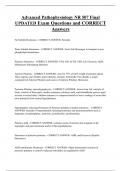Advanced Pathophysiology NR 507 Final
UPDATED Exam Questions and CORRECT
Answers
Fat Soluble Hormones - CORRECT ANSWER- Steroids
Water Soluble Hormones - CORRECT ANSWER- Need 2nd Messenger to transport across
phospholipid membranes
Pituitary Hormones - CORRECT ANSWER- TSH, GH, ACTH, FSH, LH, Oxytocin, ADH,
Melanocyte Stimulating Hormone
Anterior Pituitary - CORRECT ANSWER- Acct for 75% of total weight of pituitary gland.
Three regions, pars distalis, parts tuberalis, and pars intermedia. Pars distalis is major
component of Anterior Pituitary and source of Anterior Pituitary Hormones.
Posterior Pituitary (neurohypophysis) - CORRECT ANSWER- Arises from 3rd ventricle of
brain, consists of three parts, median eminence, pituitary stalk, and infundibular process (pars
nervosa or neural tube). Median eminence is composed mainly of nerve endings of axons that
arise primarily from ventral hypothalamus.
Hypothalamic releasing Hormones in Posterior pituitary's median eminence. - CORRECT
ANSWER- Includes 10 hypothalamic releasing hormones and neurotransmitters such as
dopamine, norepinephrine, serotonin, acetylcholine, and histamine.
Pituitary stalk - CORRECT ANSWER- contains axons of neurons that originate in the
supraoptic and paraventricular nuclei of the hypothalamus.
Hormones of posterior pituitary - CORRECT ANSWER- ADH, and Oxytocin (Peptide
Hormones)
ADH (antidiuretic Hormone) - CORRECT ANSWER- Major homeostatic function of
posterior pituitary is control of plasma osmolality, as regulated by ADH
,Hypothalamic hormones and target tissues (Hypophysiotropic hormones) - CORRECT
ANSWER- HORMONES: Thyrotropin Releasing Hormone (TRH), Gonadotropoin-releasing
hormone (GnRH), Somatostatin, Growth hormone-releasing hormone (GHRH),
corticotropin-releasing hormone (CRH),
Substance P, Dopamine, Prolactin-releasing factor.
TARGET Tissue: Anterior Pituitary
Somatostatin - CORRECT ANSWER- Inhibits release of growth hormone and TSH
Gonadotropoin-releasing hormone - CORRECT ANSWER- Stimulates release of FSH and
LH
Dopamine - CORRECT ANSWER- Inhibits synthesis and secretion of prolactin
Prolactin-releasing factor (PRF) - CORRECT ANSWER- Stimulate secretion of prolactin
Tropic Hormones of Anterior Pituitary and their function - CORRECT ANSWER- ACTH,
Melanocyte-stimulating Hormone (MSH, Somatotropic hormones, GH, prolactin, LH, TSH,
FSH, glycoprotein hormones
Adrenocorticotropic hormone (ACTH) - CORRECT ANSWER- SECRETORY CELL TYPE:
Corticotropic
TARGET ORGANS: Adrenal Gland (cortex)
FUNCTIONS: Increased steroidogenesis (cortisol, and androgenic hormones
Prolactin, - CORRECT ANSWER- Milk production
TSH - CORRECT ANSWER- Increased production and secretion of thyroid hormone
Luteinizing Hormone (LH) - CORRECT ANSWER- Ovulation, progesterone production (in
glanulosa cells)
, Follicle Stimulating Hormone (FSH) - CORRECT ANSWER- Follicle maturation, estrogen
production (In Women: Granulosa Cells, In Men: Sertoli Cells)
B-Lipotropin - CORRECT ANSWER- Fat breakdown and release of fatty acids
(Corticotropic, from Adipose Cells)
B-Endorphins - CORRECT ANSWER- Analgesia; may regulate body temp, food and water
intake (Corticotropic, Adipose cells, brain opioid receptors)
ADH functions - CORRECT ANSWER- Homeostasis, control plasma osmolality. Acts of
Vasopressin 2 (V2) receptors of renal tubular cells to increase permeability which leads to
increased water reabsorption into the blood and production of more concentrated urine, these
may be inhibited by hypercalcemia, prostaglandin E, and hypokalemia.
Osmoreceptors - CORRECT ANSWER-
High levels of ADH - CORRECT ANSWER- Acts on Vasopressin 1 receptors causing
vasoconstriction
ADH secretion is controlled by: - CORRECT ANSWER- osmoreceptors of the
hypothalamus. Stimulated by increased plasma osmolality, then ADH secretion is increased,
water is then reabsorbed from the kidney, and plasma is diluted to its' setpoint osmolality
(280 mOsm/kg). ADH has an indirect affect on electrolyte levels due to increased water
reabsorption. Electrolytes may decrease.
ADH secretion is also increased by changes in intravascular volume monitored by
mechanoreceptors in left atrium and carotid and aortic arches. Volume loss through trauma
(7%-25%) acts on receptors to stimulate ADH secretion.
ADH secretion decreased with: - CORRECT ANSWER- Decrease in plasma osmolality,
increase in intravascular volume, hypertension, increase in estrogen, progesterone,
angiotensin II levels, and alcohol ingestion
ADH (given as Vasopressin) may help to: - CORRECT ANSWER- Increase BP and to
achieve hemostasis during volume loss during shock states.




